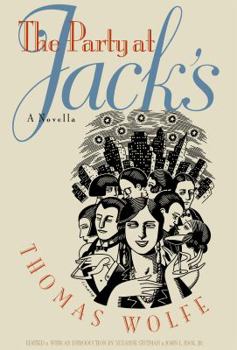The Party at Jack's: A Novella
Select Format
Select Condition 
Book Overview
In the summer of 1937, Thomas Wolfe was in the North Carolina mountains revising a piece about a party and subsequent fire at the Park Avenue penthouse apartment of the fictional Esther and Frederick Jack. He wrote to his agent, Elizabeth Nowell, 'I think it is now a single thing, as much a single thing as anything I've ever written.' Abridged and edited versions of the story were published twice, as a novella in Scribner's Monthly (May 1939) and as part of You Can't Go Home Again (1940). Now Suzanne Stutman and John Idol have worked from manuscript sources at Harvard University to reconstruct The Party at Jack's as outlined by Wolfe before his death. Here, in its untruncated state, Wolfe's novella affords a significant glimpse of a Depression-era New York inhabited by Wall Street wheelers and dealers and the theatrical and artistic elite. Wolfe describes the Jacks and their social circle with lavish attention to mannerisms and to clothing, furnishings, and other trappings of wealth and privilege. The sharply drawn contrast between the decadence of the party-goers and the struggles of the working classes in the streets below reveals Wolfe's gifts as both a writer and a sharp social critic.
Format:Hardcover
Language:English
ISBN:080782206X
ISBN13:9780807822067
Release Date:February 2001
Publisher:University of North Carolina Press
Length:274 Pages
Weight:1.40 lbs.
Dimensions:1.0" x 6.1" x 9.3"
Customer Reviews
2 ratings
Satisfying, though a draft
Published by Thriftbooks.com User , 17 years ago
Stutman and Idol offer a generous and judicious working draft of an ambitious novel, some of which Wolfe's posthumous editor, Edward C. Aswell, included in his version of You Can't Go Home Again. Set in Manhattan at the zenith of the Jazz Age, the story concerns a "power couple" who exemplify the ambition, idealism, infatuations, compromise, materialism, and tragedy of a time and place that did much to define American culture. The opening chapters essay a multileveled psychological and behavioral portrait of the husband, Friederick Jack. The meditative pace, reminiscent of Goncharov or Proust, is energized by some of Wolfe's most daring and experimental writing. The main thread of the book, however, begins with Wolfe's parallel portrait of the wife, Esther Jack. The party at Jack's is her party, and Wolfe takes great pains to portray in frank detail the social, sexual, creative, and moral dichotomies revealed by the big event. You can feel Wolfe trying to work through his own conflicting emotions as he develops this work. He makes no attempt to hide his discomfort with aesthetics and lifestyles that celebrate ironic detachment or that privilege form over content. Yet just when he seems to risk a descent into merely reflexive criticism of the jazz decade, Wolfe pushes the story (through convincing plot details) into new places where it pulses with empathy and achieves transcendence. In the end, the novel is a portrait of human caring and blindness, filled with colorful details of its era. Although redundant sentences and descriptive adjectives throughout indicate the state of draft, I found it hard to put down.
i smell poop
Published by Thriftbooks.com User , 26 years ago
no it's not poop, it's chicke






